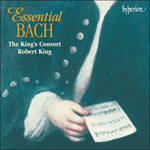
Welcome to Hyperion Records, an independent British classical label devoted to presenting high-quality recordings of music of all styles and from all periods from the twelfth century to the twenty-first.
Hyperion offers both CDs, and downloads in a number of formats. The site is also available in several languages.
Please use the dropdown buttons to set your preferred options, or use the checkbox to accept the defaults.

For the first movement the opening Sinfonia to Cantata 169 appears to be the purest source, since the right hand of the solo organ part can be transcribed for the new solo instrument whereas the later harpsichord concerto is full of additional keyboard figurations. In the second movement, a Siciliano eminently suited to the oboe, Bach shortens the harpsichord version by eight bars, missing out a ritornello (and introducing a sudden harmonic shift), though he had included this section in the cantata, where the singer might well have needed to take a breath. The version recorded here grants the soloist that respite too. For the last movement the Cantata 49 version is used as the principal reference, though the harpsichord version is turned to at two points, substituting an unidiomatic repeated note with the harpsichord’s trill, and filling in the oboe’s line at two sparsely scored bars with the harpsichord’s added concerto part.
from notes by Robert King © 1988
Pour le premier mouvement, la Sinfonia d’ouverture de la Cantate 169 semble la source la plus pure, la main droite de la partie d’orgue solo pouvant être transcrite pour le nouvel instrument solo, là où le concerto pour clavecin regorge de figures additionnelles pour clavier. Dans le deuxième mouvement, une sicilienne parfaitement adaptée au hautbois, Bach raccourcit la version pour clavecin de huit mesures, omettant un ritornello (et introduisant une brusque transition harmonique)—une section qu’il avait pourtant incluse dans la cantate, à un moment où le chanteur avait sûrement besoin de reprendre son souffle. La version enregistrée ici accorde, elle aussi, ce répit au soliste. Le dernier mouvement se réfère principalement à la Cantate 49, la mouture pour clavecin étant utilisée seulement pour remplacer une note répétée non idiomatique par le trille du clavecin et pour combler la ligne de hautbois (à deux mesures peu écrites) avec la partie concertante pour clavecin.
extrait des notes rédigées par Robert King © 1988
Français: Hypérion
Für den ersten Satz des Originalkonzerts scheint die einleitende Sinfonia aus der Kantate BWV169 die reinste Quelle zu sein, da die rechte Hand der solistisch spielenden Orgelstimme für das neue Soloinstrument einfach übernommen werden kann, wohingegen das spätere Cembalokonzert voller zusätzlicher virtuoser Cembaloverzierungen ist. Der zweite Satz ist ein Siciliano und eignet sich hervorragend für die Oboe. In der Cembalofassung kürzte Bach den Satz um acht Takte, indem er ein Ritornell strich (und eine unerwartete harmonische Wendung einführte). Man weiß um diese Streichung, weil dieser Abschnitt in der Kantate enthalten ist, wo sich die Sängerin eigentlich über eine Atempause gefreut hätte. Die hier eingespielte Fassung gestattet dem Solisten auch diese Pause. Für den letzten Satz erwies sich die Kantate BWV49 als Hauptquelle, auch wenn an zwei Stellen die Cembalokonzertfassung herangezogen wurde, wobei eine für die Oboe unpassende Tonwiederholung einem Cembalotriller wich und die Oboenstimme in zwei dünn besetzten Takten durch die Übernahme von Cembaloverzierungen Verstärkung fand.
aus dem Begleittext von Robert King © 1988
Deutsch: Elke Hockings
 Essential Bach Essential Bach'This is a good introduction to Bach and a useful disc for those who want to sample his varied music' (Contemporary Review)» More |

